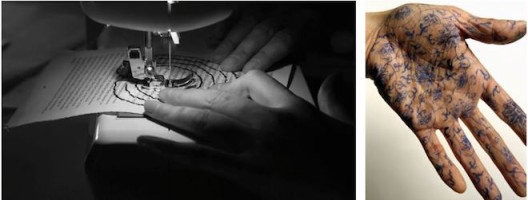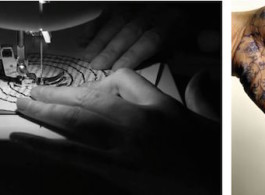Curated by David Ho Yeung Chan

Left: Ni Haifeng b. 1964, Tautology, 2014, HD video installation, Edition 1 of 3 + 1 AP
Right: Self Portrait as Part of the Porcelain Export History, 1999, Photograph, 142 x 120 cm (55 7/8 x 47 1/4 in.), Edition 3/3 + 1AP
Exhibition Dates
31 July–2 September, 2015
Monday–Saturday, 10am–7pm
Pearl Lam Galleries, 6/F, Pedder Building, 12 Pedder Street, Central, Hong Kong
Hong Kong—Pearl Lam Galleries presents a solo exhibition by Amsterdam and Beijing-based artist Ni Haifeng, featuring works from the late 1980s to the present. The exhibition invites viewers to draw parallel meanings between the artworks and, in doing so, to contemplate on their narrative as a whole. Ni’s artwork refutes a linear or chronological interpretation by staging an experience that situates art, in the artist’s words, “in a zero moment or an instant of no gravity.” The exhibition opens today and runs through 2 September, 2015.
For we must read between the lines; removing the artwork’s temporal and physical content involves interrogating the politics of representation and exposing the inherent ideological structure that uses art to legitimate a set historical trajectory. This predicament is often done at the expense of concealing the maker’s own nuances that are inherently personal and humanistic in nature. Asynchronous, Parallel, Tautological, et cetera… investigates the gap that demarcates the artist’s own experiences and how the experiences resist the compartmentalisation of meaning within a coherent master narrative. Furthermore, Ni’s marginal position in the art world provides a unique perspective for exposing the broader social economic circumstances surrounding his working process and how they affect his self-identity.

As Homi Bhabha writes, “It is from the instability of cultural signification that the national culture comes to be articulated as dialectic of various temporalities—modern, colonial, postcolonial, native [...] It is always contemporaneous with the act of recitation—I have heard and you will hear.”
This exhibition is not intended to be a retrospective; instead, Ni’s selection of artworks aims to open up new possibilities for reading the artworks that are not bound by the binary oppositions of “I have heard” and “you will hear”. To destabilise our reading of the artworks, Ni reverses the gaze back at the beholders and asks us how we would give meaning to an experience that is autobiographical in nature. Who are we to judge the history of another individual, let alone its place in history, for the artist is never an auteur in the first place. While many embrace the new promises of cultural hybridity, Ni reveals the psychological impacts that colonisation and economic globalisation have on our subjectivities, how best to counter the demand for self-ethnicity as a potent form of cultural capital in an ever expansive cultural economy.
By being immersed in a cyclical narrative, this exhibition provides audiences with multiple points of departure. In essence, Asynchronous, Parallel, Tautological, et cetera… maps out Ni’s contingent yet highly adaptive strategies: from translating a personal experience with writing to inscribing the experience on the body, or the retrieval of oneself after appropriating the culture of another to the desire to self-destruct as a way of protesting the demand for an incessant production of meaning. These issues are not only the rubric governing this exhibition, but are also timely for a post-colony turned global city like Hong Kong to reassess its own identity as it aspires to become a cultural capital.
Unfinished Self Portrait is an installation that translates the self-portrait from a passport into a series of illegible textual and digital codes. It can be read as an outright rejection of representing oneself in a site that celebrates authorship and authenticity. The Warehouse is a series of photographs from the late 1980s that conveys our desire to project personal memories onto a physical origin that is always subject to change. By documenting the journey from Beijing to Amsterdam, Penumbra expresses the need for transgression and our inability to discern the differences between a private and a public sphere. Cast in bronze, The Keeping of Things is a collection of personal objects, accumulated thus far over the artist’s lifespan, that are autobiographical in nature. These seemingly mundane objects function as a remnant for reflecting on the erasure of personal traits from the grand history of our time. Self Portrait as Part of the Porcelain Export History addresses the way in which colonial history has infringed on our body in the name of otherness, an issue central to the discussion of identity politics during the 1990s. Domesticated reiterates the importance of writing as an intellectual refuge for preserving oneself. Unravelling is a double channel video that depicts a female worker tearing apart a book and subsequently stitching it back together; the boundaries separating labour, control, and artistic practice become blurry. Commodity and Money depicts a page from Karl Marx’s Critique of Capitalism that is covered with dust and connotes a decay and general fatigue with the many promises of a capitalist society. Tautology documents a worker who uses a sewing machine to create a complex pattern on an art history book. The modes of cultural production and industrial production have become increasingly alike.
Ni’s self-critique is pertinent for questioning the contradictory role of an artist as an agency for change or as a mere service provider. The fragmentation of self resonates with a dissonance in this exhibition that falls in and out of our narration; for we must resort to improvisation and imagination as an exit or what is et cetera…
About Ni Haifeng
Ni Haifeng was born in 1964 in Zhoushan, China. In 1986, he graduated from Zhejiang Academy of Fine Arts, which is now the China Academy of Art. He currently lives and works between Amsterdam and Beijing.
Ni Haifeng’s practice draws from an interest in cultural systems of exchange, return, language and production. Through photography, video, and installation he explores the simultaneous creation
and obliteration of meaning while drawing attention to the cyclical movements of people, products and goods that are often reflective of patterns of colonialism and globalisation.
After graduating from the Zhejiang Academy of Fine Art, Ni joined RED 70%, BLACK 25%, WHITE 5%, a group of artists who worked with conceptual art and nonsense text. These early works focused on acts of writing, reappropriations and deconstructed forms of language. Since the mid 1990s, after emigrating to Europe, Ni’s work has acquired additional layers referring to his new identity as a Chinese immigrant, and to issues of (post-)colonialism and ‘otherness’. Ni created a series of installations that featured objects and tableaux suspended from knotted ropes. Precariousness and instability are dominant factors in these works, as is the persistent sense of weight, balance and feeling of danger elicited in the viewer. In recent years, overt and covert references to manufacturing and production have formed recurring themes within Ni’s artistic practice.
Ni Haifeng’s work has been exhibited throughout Asia and Europe in selected solo exhibitions including Project for Ignatius (2012), St. Ignatius Gymnasium, Amsterdam, The Netherlands (Public work); Vive la Difference (2010), Gallery Lumen Travo, Amsterdam, The Netherlands; Of the Departure and the Arrival (2009), Teemtower, Guangzhou; Para-Production (2008), Joyart, Beijing; The Return of the Shreds (in collaboration with Kitty Zijlmans), Stedelijk Museum De Lakenhal in Scheltema, Leiden; and Ni Haifeng. Xeno-Writings (2004), Museum Het Domein, Sittard. Selected group shows include Dai Hanzi: 5000 artists (2014), Witte de With Center for Contemporary Art, Rotterdam, the Netherlands; Manifesta 9—The Deep of the Modern (2012), Waterscai, Genk, Belgium; Silent Writings (2009), Espace Culturel Louis Vuitton, Paris; Begegnung mit den Anderen (1992), K18, Kassel, Germany. His works have been collected by M+, West Kowloon Cultural District in Hong Kong, China; Guangdong Museum of Art in Guangzhou, China; Museum Huis Marseille in Amsterdam, The Netherlands; Museum De Lakenhal in Lakenhal, The Netherlands; Queensland Art Gallery in Brisbane, Australia; and other public collections.
About David Ho Yeung Chan
David Ho Yeung Chan is a curator based in Hong Kong. With Pearl Lam Galleries, Chan has curated Lei Hong: Non-Geometric Study (2012), Tsang Kin-Wah: Ecce Homo Trilogy I (2012), Fictional Recoveries (2012), Su Xiaobai (2013), Déjà Disparu (2013), After Time (2014), and Ren Ri: Yuansu Projects (2015). He holds an MA from the Center for Curatorial Studies at Bard College, New York, USA.
About Pearl Lam Galleries
Founded by Pearl Lam, Pearl Lam Galleries is a driving force within Asia’s contemporary art scene. With over 20 years of experience exhibiting Asian and Western art and design, it is one of the leading and most established contemporary art galleries to be launched out of China.
Playing a vital role in stimulating international dialogue on Chinese and Asian contemporary art, the Galleries is dedicated to championing artists who re-evaluate and challenge perceptions of cultural practice from the region. The Galleries in Hong Kong, Shanghai, and Singapore collaborate with renowned curators, each presenting distinct programming from major solo exhibitions, special projects, and installations to conceptually rigorous group shows. Based on the philosophy of Chinese Literati where art forms have no hierarchy, Pearl Lam Galleries is dedicated to breaking down boundaries between different disciplines, with a unique gallery model committed to encouraging cross-cultural exchange.
Contemporary Chinese Abstract art is heavily represented in the Galleries roster. Influential Chinese artists Zhu Jinshi and Su Xiaobai, who synthesise Chinese sensibilities with an international visual language, are presented internationally with work now included in major private and public collections worldwide. The Galleries has also introduced leading international artists such as Jenny Holzer, Jim Lambie, and Yinka Shonibare MBE (RA) to markets in the region, providing opportunities for new audiences in Asia to encounter their work. Pearl Lam Galleries
encourages international artists to create new work which engages specifically with the region- collaborating to produce thought-provoking, culturally relevant work.



